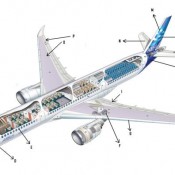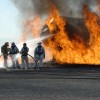Parts of an Aircraft

[audio:https://aviationenglishblog.com/wp-content/uploads/2010/09/04partsofanaircraft.mp3|titles=Parts of an Aircraft]TOPIC: Parts of an Aircraft
GOAL: To learn the major parts of an aircraft by location and function
Level: Easy
1. Read about the various major parts of an airplane, then proceed to Step 2
Although there are many aircraft designs flying today, most of them share a common assembly of major parts that all pilots should be thoroughly aware of. Ever since the early days of aviation, an aviator’s primary training included the fundamental knowledge of what each part is called, its function and where it is located.
Each major part of a fixed-wing aircraft serves an important purpose. For example, the propeller helps move the aircraft through the air via thrust. The wings are lifting bodies which help keep the aircraft airborne. The horizontal and vertical stabilizers contain vital control surfaces; and the fuselage is a major structural component containing crew and passenger areas.

























Recent Comments